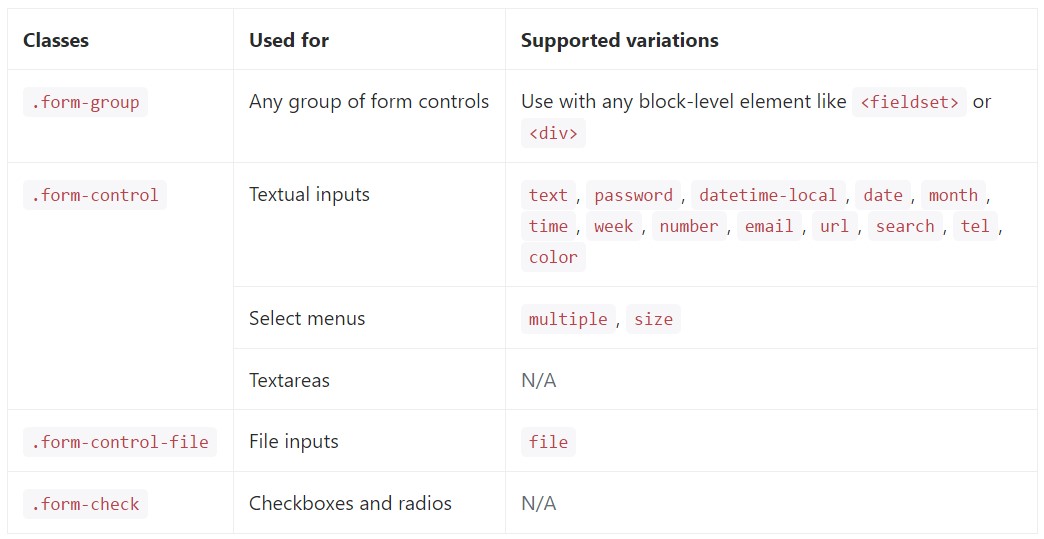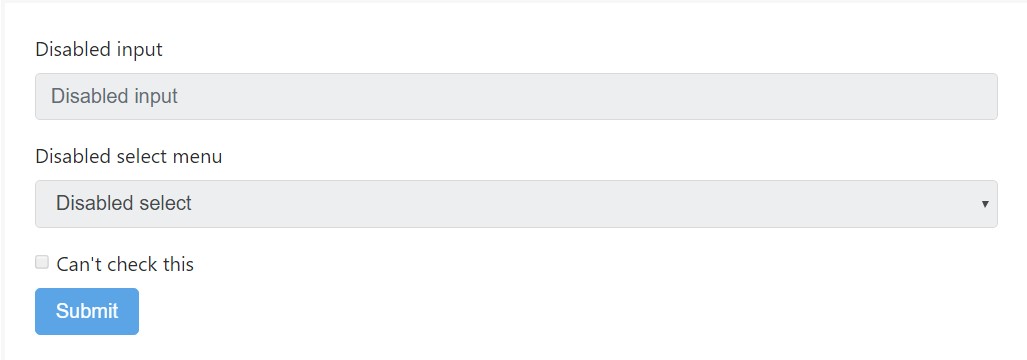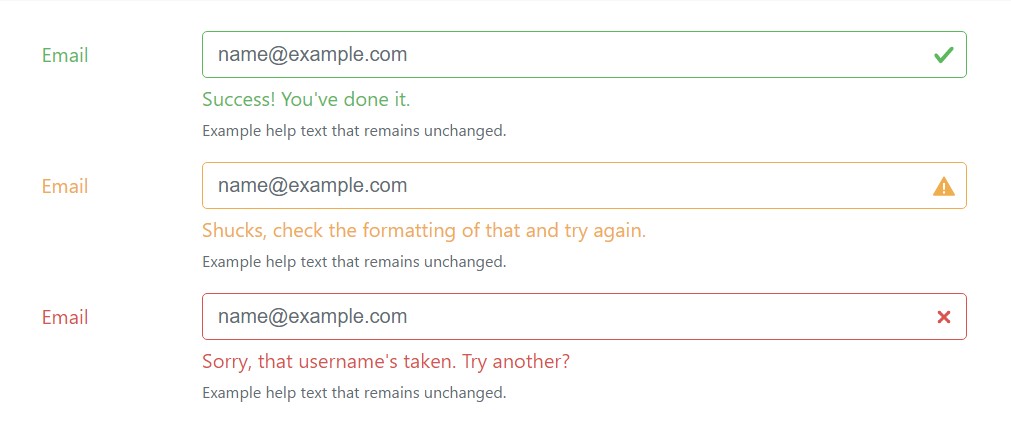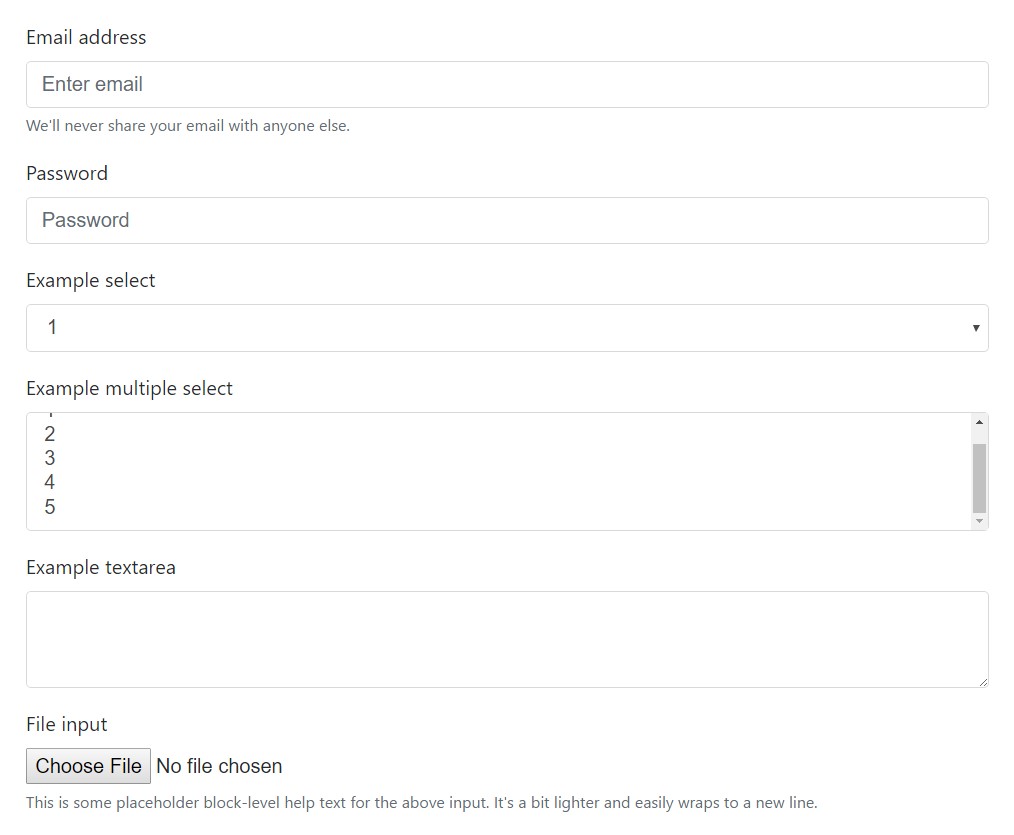Bootstrap Form Inline
Intro
Bootstrap grants numerous form manage appearances, layout features, and also custom-made components for making a variety of Bootstrap Form Group.
Forms deliver the best option for scoring several responses directly from the website visitors of our web pages. In case that it is really a straightforward connection or possibly registration form using simply a few areas or else a complicated and well thought examination the Bootstrap 4 system got all things that is actually required to complete the function and obtain fantastic responsive appeal.
By default within the Bootstrap framework the form components are designated to span all width of its parent feature-- this stuff gets achieved by assigning the
.form-control.form-groupBootstrap Form Group regulations
Bootstrap's form commands develop upon our Rebooted form appearances with classes.
Use these classes to opt inside their customized displays for a even more steady rendering across gadgets and internet browsers . The sample form listed here illustrates basic HTML form components that get modified looks from Bootstrap plus more classes.
Take note, considering Bootstrap uses the HTML5 doctype, all of the inputs need to possess a
type
<form>
<div class="form-group">
<label for="exampleInputEmail1">Email address</label>
<input type="email" class="form-control" id="exampleInputEmail1" aria-describedby="emailHelp" placeholder="Enter email">
<small id="emailHelp" class="form-text text-muted">We'll never share your email with anyone else.</small>
</div>
<div class="form-group">
<label for="exampleInputPassword1">Password</label>
<input type="password" class="form-control" id="exampleInputPassword1" placeholder="Password">
</div>
<div class="form-group">
<label for="exampleSelect1">Example select</label>
<select class="form-control" id="exampleSelect1">
<option>1</option>
<option>2</option>
<option>3</option>
<option>4</option>
<option>5</option>
</select>
</div>
<div class="form-group">
<label for="exampleSelect2">Example multiple select</label>
<select multiple class="form-control" id="exampleSelect2">
<option>1</option>
<option>2</option>
<option>3</option>
<option>4</option>
<option>5</option>
</select>
</div>
<div class="form-group">
<label for="exampleTextarea">Example textarea</label>
<textarea class="form-control" id="exampleTextarea" rows="3"></textarea>
</div>
<div class="form-group">
<label for="exampleInputFile">File input</label>
<input type="file" class="form-control-file" id="exampleInputFile" aria-describedby="fileHelp">
<small id="fileHelp" class="form-text text-muted">This is some placeholder block-level help text for the above input. It's a bit lighter and easily wraps to a new line.</small>
</div>
<fieldset class="form-group">
<legend>Radio buttons</legend>
<div class="form-check">
<label class="form-check-label">
<input type="radio" class="form-check-input" name="optionsRadios" id="optionsRadios1" value="option1" checked>
Option one is this and that—be sure to include why it's great
</label>
</div>
<div class="form-check">
<label class="form-check-label">
<input type="radio" class="form-check-input" name="optionsRadios" id="optionsRadios2" value="option2">
Option two can be something else and selecting it will deselect option one
</label>
</div>
<div class="form-check disabled">
<label class="form-check-label">
<input type="radio" class="form-check-input" name="optionsRadios" id="optionsRadios3" value="option3" disabled>
Option three is disabled
</label>
</div>
</fieldset>
<div class="form-check">
<label class="form-check-label">
<input type="checkbox" class="form-check-input">
Check me out
</label>
</div>
<button type="submit" class="btn btn-primary">Submit</button>
</form>Shown below is a complete catalog of the particular Bootstrap Form Template regulations upheld by Bootstrap together with the classes that personalize them. Supplementary information is offered for each group.

Textual inputs
Right here are the some examples of
.form-control<input>type
<div class="form-group row">
<label for="example-text-input" class="col-2 col-form-label">Text</label>
<div class="col-10">
<input class="form-control" type="text" value="Artisanal kale" id="example-text-input">
</div>
</div>
<div class="form-group row">
<label for="example-search-input" class="col-2 col-form-label">Search</label>
<div class="col-10">
<input class="form-control" type="search" value="How do I shoot web" id="example-search-input">
</div>
</div>
<div class="form-group row">
<label for="example-email-input" class="col-2 col-form-label">Email</label>
<div class="col-10">
<input class="form-control" type="email" value="[email protected]" id="example-email-input">
</div>
</div>
<div class="form-group row">
<label for="example-url-input" class="col-2 col-form-label">URL</label>
<div class="col-10">
<input class="form-control" type="url" value="https://getbootstrap.com" id="example-url-input">
</div>
</div>
<div class="form-group row">
<label for="example-tel-input" class="col-2 col-form-label">Telephone</label>
<div class="col-10">
<input class="form-control" type="tel" value="1-(555)-555-5555" id="example-tel-input">
</div>
</div>
<div class="form-group row">
<label for="example-password-input" class="col-2 col-form-label">Password</label>
<div class="col-10">
<input class="form-control" type="password" value="hunter2" id="example-password-input">
</div>
</div>
<div class="form-group row">
<label for="example-number-input" class="col-2 col-form-label">Number</label>
<div class="col-10">
<input class="form-control" type="number" value="42" id="example-number-input">
</div>
</div>
<div class="form-group row">
<label for="example-datetime-local-input" class="col-2 col-form-label">Date and time</label>
<div class="col-10">
<input class="form-control" type="datetime-local" value="2011-08-19T13:45:00" id="example-datetime-local-input">
</div>
</div>
<div class="form-group row">
<label for="example-date-input" class="col-2 col-form-label">Date</label>
<div class="col-10">
<input class="form-control" type="date" value="2011-08-19" id="example-date-input">
</div>
</div>
<div class="form-group row">
<label for="example-month-input" class="col-2 col-form-label">Month</label>
<div class="col-10">
<input class="form-control" type="month" value="2011-08" id="example-month-input">
</div>
</div>
<div class="form-group row">
<label for="example-week-input" class="col-2 col-form-label">Week</label>
<div class="col-10">
<input class="form-control" type="week" value="2011-W33" id="example-week-input">
</div>
</div>
<div class="form-group row">
<label for="example-time-input" class="col-2 col-form-label">Time</label>
<div class="col-10">
<input class="form-control" type="time" value="13:45:00" id="example-time-input">
</div>
</div>
<div class="form-group row">
<label for="example-color-input" class="col-2 col-form-label">Color</label>
<div class="col-10">
<input class="form-control" type="color" value="#563d7c" id="example-color-input">
</div>
</div>Form configurations
Considering that Bootstrap applies
display: blockwidth :100%Form groups
The
.form-groupmargin-bottom<fieldset><div>
<form>
<div class="form-group">
<label for="formGroupExampleInput">Example label</label>
<input type="text" class="form-control" id="formGroupExampleInput" placeholder="Example input">
</div>
<div class="form-group">
<label for="formGroupExampleInput2">Another label</label>
<input type="text" class="form-control" id="formGroupExampleInput2" placeholder="Another input">
</div>
</form>Inline forms
Operate the
.form-inline- Controls are
display: flex- Controls and input groups earn
width: autowidth: 100%- Controls only show up inline inside viewports which are at very least 576px big to account for narrow viewports on mobile devices.
You may possibly have to by hand resolve the width and placement of specific form controls with spacing utilities (as revealed below) And lastly, don't forget to constantly involve a
<label>
<form class="form-inline">
<label class="sr-only" for="inlineFormInput">Name</label>
<input type="text" class="form-control mb-2 mr-sm-2 mb-sm-0" id="inlineFormInput" placeholder="Jane Doe">
<label class="sr-only" for="inlineFormInputGroup">Username</label>
<div class="input-group mb-2 mr-sm-2 mb-sm-0">
<div class="input-group-addon">@</div>
<input type="text" class="form-control" id="inlineFormInputGroup" placeholder="Username">
</div>
<div class="form-check mb-2 mr-sm-2 mb-sm-0">
<label class="form-check-label">
<input class="form-check-input" type="checkbox"> Remember me
</label>
</div>
<button type="submit" class="btn btn-primary">Submit</button>
</form>Custom form controls plus picks are as well supported.

<form class="form-inline">
<label class="mr-sm-2" for="inlineFormCustomSelect">Preference</label>
<select class="custom-select mb-2 mr-sm-2 mb-sm-0" id="inlineFormCustomSelect">
<option selected>Choose...</option>
<option value="1">One</option>
<option value="2">Two</option>
<option value="3">Three</option>
</select>
<label class="custom-control custom-checkbox mb-2 mr-sm-2 mb-sm-0">
<input type="checkbox" class="custom-control-input">
<span class="custom-control-indicator"></span>
<span class="custom-control-description">Remember my preference</span>
</label>
<button type="submit" class="btn btn-primary">Submit</button>
</form>Alternatives to covered up labels
Assistive modern technologies for example, screen readers will have problem utilizing your forms in the event that you don't involve a label for each input. For these kinds of inline forms, you can surely cover up the labels applying the
.sr-onlyaria-labelaria-labelledbytitleplaceholderplaceholderUsing the Grid
For even more designed form layouts which are also responsive, you can make use of Bootstrap's predefined grid classes as well as mixins to produce horizontal forms. Provide the
.row.col-*-*Be sure to add
.col-form-label<label><legend>.col-form-legend<label>
<div class="container">
<form>
<div class="form-group row">
<label for="inputEmail3" class="col-sm-2 col-form-label">Email</label>
<div class="col-sm-10">
<input type="email" class="form-control" id="inputEmail3" placeholder="Email">
</div>
</div>
<div class="form-group row">
<label for="inputPassword3" class="col-sm-2 col-form-label">Password</label>
<div class="col-sm-10">
<input type="password" class="form-control" id="inputPassword3" placeholder="Password">
</div>
</div>
<fieldset class="form-group row">
<legend class="col-form-legend col-sm-2">Radios</legend>
<div class="col-sm-10">
<div class="form-check">
<label class="form-check-label">
<input class="form-check-input" type="radio" name="gridRadios" id="gridRadios1" value="option1" checked>
Option one is this and that—be sure to include why it's great
</label>
</div>
<div class="form-check">
<label class="form-check-label">
<input class="form-check-input" type="radio" name="gridRadios" id="gridRadios2" value="option2">
Option two can be something else and selecting it will deselect option one
</label>
</div>
<div class="form-check disabled">
<label class="form-check-label">
<input class="form-check-input" type="radio" name="gridRadios" id="gridRadios3" value="option3" disabled>
Option three is disabled
</label>
</div>
</div>
</fieldset>
<div class="form-group row">
<label class="col-sm-2">Checkbox</label>
<div class="col-sm-10">
<div class="form-check">
<label class="form-check-label">
<input class="form-check-input" type="checkbox"> Check me out
</label>
</div>
</div>
</div>
<div class="form-group row">
<div class="offset-sm-2 col-sm-10">
<button type="submit" class="btn btn-primary">Sign in</button>
</div>
</div>
</form>
</div>Grid-based form design and styles in addition support small and big inputs.

<div class="container">
<form>
<div class="form-group row">
<label for="lgFormGroupInput" class="col-sm-2 col-form-label col-form-label-lg">Email</label>
<div class="col-sm-10">
<input type="email" class="form-control form-control-lg" id="lgFormGroupInput" placeholder="[email protected]">
</div>
</div>
<div class="form-group row">
<label for="smFormGroupInput" class="col-sm-2 col-form-label col-form-label-sm">Email</label>
<div class="col-sm-10">
<input type="email" class="form-control form-control-sm" id="smFormGroupInput" placeholder="[email protected]">
</div>
</div>
</form>
</div>Checkboxes and radios
Default radios and checkboxes are enhanced upon with the support of
.form-checkThe disabled class is going to at the same time make lighter the message coloration to help indicate the input's state.
Each checkbox and radio is wrapped in a
<label>- It supplies a greater hit areas for checking the control.
- It provides a semantic and handy wrapper to assist us substitute the default
<input>- It activates the state of the
<input>We cover the default
<input>opacity.custom-control-indicator<input>contentWe use the relative selector
~<input>: checked.custom-control-description<input>In the checked states, we use base64 embedded SVG icons from Open Iconic. This provides us the best control for styling and positioning across browsers and devices.
Checkboxes

<label class="custom-control custom-checkbox">
<input type="checkbox" class="custom-control-input">
<span class="custom-control-indicator"></span>
<span class="custom-control-description">Check this custom checkbox</span>
</label>Customized checkboxes can also utilize the
: indeterminate
In case you're working with jQuery, something like this should really do the trick:
$('.your-checkbox').prop('indeterminate', true)Radios

<label class="custom-control custom-radio">
<input id="radio1" name="radio" type="radio" class="custom-control-input">
<span class="custom-control-indicator"></span>
<span class="custom-control-description">Toggle this custom radio</span>
</label>
<label class="custom-control custom-radio">
<input id="radio2" name="radio" type="radio" class="custom-control-input">
<span class="custom-control-indicator"></span>
<span class="custom-control-description">Or toggle this other custom radio</span>
</label>Default (stacked)
By default, any number of checkboxes and radios which are certainly immediate sibling will be vertically piled as well as properly spaced by using
.form-check
<div class="form-check">
<label class="form-check-label">
<input class="form-check-input" type="checkbox" value="">
Option one is this and that—be sure to include why it's great
</label>
</div>
<div class="form-check disabled">
<label class="form-check-label">
<input class="form-check-input" type="checkbox" value="" disabled>
Option two is disabled
</label>
</div>
<div class="form-check">
<label class="form-check-label">
<input class="form-check-input" type="radio" name="exampleRadios" id="exampleRadios1" value="option1" checked>
Option one is this and that—be sure to include why it's great
</label>
</div>
<div class="form-check">
<label class="form-check-label">
<input class="form-check-input" type="radio" name="exampleRadios" id="exampleRadios2" value="option2">
Option two can be something else and selecting it will deselect option one
</label>
</div>
<div class="form-check disabled">
<label class="form-check-label">
<input class="form-check-input" type="radio" name="exampleRadios" id="exampleRadios3" value="option3" disabled>
Option three is disabled
</label>
</div>Inline
Group checkboxes or else radios on the exact same horizontal row with adding
.form-check-inline.form-check
<div class="form-check form-check-inline">
<label class="form-check-label">
<input class="form-check-input" type="checkbox" id="inlineCheckbox1" value="option1"> 1
</label>
</div>
<div class="form-check form-check-inline">
<label class="form-check-label">
<input class="form-check-input" type="checkbox" id="inlineCheckbox2" value="option2"> 2
</label>
</div>
<div class="form-check form-check-inline disabled">
<label class="form-check-label">
<input class="form-check-input" type="checkbox" id="inlineCheckbox3" value="option3" disabled> 3
</label>
</div>
<div class="form-check form-check-inline">
<label class="form-check-label">
<input class="form-check-input" type="radio" name="inlineRadioOptions" id="inlineRadio1" value="option1"> 1
</label>
</div>
<div class="form-check form-check-inline">
<label class="form-check-label">
<input class="form-check-input" type="radio" name="inlineRadioOptions" id="inlineRadio2" value="option2"> 2
</label>
</div>
<div class="form-check form-check-inline disabled">
<label class="form-check-label">
<input class="form-check-input" type="radio" name="inlineRadioOptions" id="inlineRadio3" value="option3" disabled> 3
</label>
</div>Free from labels
You really should not provide a text inside the
<label>aria-label
<div class="form-check">
<label class="form-check-label">
<input class="form-check-input" type="checkbox" id="blankCheckbox" value="option1" aria-label="...">
</label>
</div>
<div class="form-check">
<label class="form-check-label">
<input class="form-check-input" type="radio" name="blankRadio" id="blankRadio1" value="option1" aria-label="...">
</label>
</div>Static regulations
In the event that you ought to put plain text beside a form label within a form, utilize the
.form-control-static
<form>
<div class="form-group row">
<label class="col-sm-2 col-form-label">Email</label>
<div class="col-sm-10">
<p class="form-control-static">[email protected]</p>
</div>
</div>
<div class="form-group row">
<label for="inputPassword" class="col-sm-2 col-form-label">Password</label>
<div class="col-sm-10">
<input type="password" class="form-control" id="inputPassword" placeholder="Password">
</div>
</div>
</form>
<form class="form-inline">
<div class="form-group">
<label class="sr-only">Email</label>
<p class="form-control-static">[email protected]</p>
</div>
<div class="form-group mx-sm-3">
<label for="inputPassword2" class="sr-only">Password</label>
<input type="password" class="form-control" id="inputPassword2" placeholder="Password">
</div>
<button type="submit" class="btn btn-primary">Confirm identity</button>
</form>Disabled status
Include the
disablednot-allowed<input class="form-control" id="disabledInput" type="text" placeholder="Disabled input here..." disabled>Add the
disabled<fieldset>
<form>
<fieldset disabled>
<div class="form-group">
<label for="disabledTextInput">Disabled input</label>
<input type="text" id="disabledTextInput" class="form-control" placeholder="Disabled input">
</div>
<div class="form-group">
<label for="disabledSelect">Disabled select menu</label>
<select id="disabledSelect" class="form-control">
<option>Disabled select</option>
</select>
</div>
<div class="checkbox">
<label>
<input type="checkbox"> Can't check this
</label>
</div>
<button type="submit" class="btn btn-primary">Submit</button>
</fieldset>
</form>Caveat about web link capability of <a>
<a>By default, browsers will treat all original form controls (
<input><select><button><fieldset disabled><a ... class="btn btn-*">pointer-events: noneCross-browser being compatible
Though Bootstrap will employ these varieties in all browsers, Internet Explorer 11 and below don't completely assist the
disabled<fieldset>Read-only inputs
Bring in the
readonly
<input class="form-control" type="text" placeholder="Readonly input here…" readonly>Control sizing
Specify heights using classes like
.form-control-lg.col-lg-*
<input class="form-control form-control-lg" type="text" placeholder=".form-control-lg">
<input class="form-control" type="text" placeholder="Default input">
<input class="form-control form-control-sm" type="text" placeholder=".form-control-sm">
<select class="form-control form-control-lg">
<option>Large select</option>
</select>
<select class="form-control">
<option>Default select</option>
</select>
<select class="form-control form-control-sm">
<option>Small select</option>
</select>Column size
Wrap inputs inside a grid columns, or else any sort of custom made parent feature, to quickly apply the wanted widths.

<div class="row">
<div class="col-2">
<input type="text" class="form-control" placeholder=".col-2">
</div>
<div class="col-3">
<input type="text" class="form-control" placeholder=".col-3">
</div>
<div class="col-4">
<input type="text" class="form-control" placeholder=".col-4">
</div>
</div>Assistance message
The
.help-block.form-text.has-feedback.form-control-danger.form-control-warning.form-control-successAffiliating assistance content with form controls
Assistance content needs to be explicitly related to the form control it really relates to using the
aria-describedbyBlock level
Block support content-- for below inputs or else for much longer lines of the support content-- can be quickly accomplished by using
.form-textdisplay: block
<label for="inputPassword5">Password</label>
<input type="password" id="inputPassword5" class="form-control" aria-describedby="passwordHelpBlock">
<p id="passwordHelpBlock" class="form-text text-muted">
Your password must be 8-20 characters long, contain letters and numbers, and must not contain spaces, special characters, or emoji.
</p>Inline
Inline message can easily utilize any kind of usual inline HTML element (be it a 'small', 'span', or another thing).

<form class="form-inline">
<div class="form-group">
<label for="inputPassword4">Password</label>
<input type="password" id="inputPassword4" class="form-control mx-sm-3" aria-describedby="passwordHelpInline">
<small id="passwordHelpInline" class="text-muted">
Must be 8-20 characters long.
</small>
</div>
</form>Validation
Bootstrap includes validation designs for warning, success, and danger states on a large number of form controls.
How to utilize
Here's a run-through of the way they function:
- To use, incorporate
.has-warning.has-danger.has-success.col-form-label.form-control- Contextual validation text message, besides your common form area guidance words, can be added along with the operation of
.form-control-feedback.has-*margincolor- Validation icons are
url()background-image- You can apply your special base64 PNGs or else SVGs by improving the Sass variables as well as recompiling.
- Icons are able to additionally be disabled entirely with setting up the variables to
noneDefining forms
Commonly speaking, you'll need to employ a particular state for certain styles of responses:
- Danger is effective for the time there's a blocking or possibly required field. A user ought to write in this specific field appropriately to provide the form.
- Warning does the job effectively for input values that are in development, like parole strength, or soft validation right before a user attempts to submit a form.
- And as a final point, success is most suitable for circumstances each time you have per-field validation all throughout a form and want to motivate a user throughout the other fields.
Examples
Here are some good examples of the aforementioned classes at work. First up is your regular left-aligned fields together with labels, help text, and validation texting.

<div class="form-group has-success">
<label class="form-control-label" for="inputSuccess1">Input with success</label>
<input type="text" class="form-control form-control-success" id="inputSuccess1">
<div class="form-control-feedback">Success! You've done it.</div>
<small class="form-text text-muted">Example help text that remains unchanged.</small>
</div>
<div class="form-group has-warning">
<label class="form-control-label" for="inputWarning1">Input with warning</label>
<input type="text" class="form-control form-control-warning" id="inputWarning1">
<div class="form-control-feedback">Shucks, check the formatting of that and try again.</div>
<small class="form-text text-muted">Example help text that remains unchanged.</small>
</div>
<div class="form-group has-danger">
<label class="form-control-label" for="inputDanger1">Input with danger</label>
<input type="text" class="form-control form-control-danger" id="inputDanger1">
<div class="form-control-feedback">Sorry, that username's taken. Try another?</div>
<small class="form-text text-muted">Example help text that remains unchanged.</small>
</div>All those exact same states have the ability to also be applied with horizontal forms.

<div class="container">
<form>
<div class="form-group row has-success">
<label for="inputHorizontalSuccess" class="col-sm-2 col-form-label">Email</label>
<div class="col-sm-10">
<input type="email" class="form-control form-control-success" id="inputHorizontalSuccess" placeholder="[email protected]">
<div class="form-control-feedback">Success! You've done it.</div>
<small class="form-text text-muted">Example help text that remains unchanged.</small>
</div>
</div>
<div class="form-group row has-warning">
<label for="inputHorizontalWarning" class="col-sm-2 col-form-label">Email</label>
<div class="col-sm-10">
<input type="email" class="form-control form-control-warning" id="inputHorizontalWarning" placeholder="[email protected]">
<div class="form-control-feedback">Shucks, check the formatting of that and try again.</div>
<small class="form-text text-muted">Example help text that remains unchanged.</small>
</div>
</div>
<div class="form-group row has-danger">
<label for="inputHorizontalDnger" class="col-sm-2 col-form-label">Email</label>
<div class="col-sm-10">
<input type="email" class="form-control form-control-danger" id="inputHorizontalDnger" placeholder="[email protected]">
<div class="form-control-feedback">Sorry, that username's taken. Try another?</div>
<small class="form-text text-muted">Example help text that remains unchanged.</small>
</div>
</div>
</form>
</div>Radios and checkboxes happen to be also assisted.

<div class="form-check has-success">
<label class="form-check-label">
<input type="checkbox" class="form-check-input" id="checkboxSuccess" value="option1">
Checkbox with success
</label>
</div>
<div class="form-check has-warning">
<label class="form-check-label">
<input type="checkbox" class="form-check-input" id="checkboxWarning" value="option1">
Checkbox with warning
</label>
</div>
<div class="form-check has-danger">
<label class="form-check-label">
<input type="checkbox" class="form-check-input" id="checkboxDanger" value="option1">
Checkbox with danger
</label>
</div>Custom-made forms
To get a lot more modification and also cross web browser stability, utilize Bootstrap completely customized form features to replace the web browser defaults. They're built on very top of available and semantic markup, in this way they're concrete substitutes for any type of default form control.
Disabled
Custom made radios and checkboxes can additionally be disabled . Provide the
disabled<input>
<label class="custom-control custom-checkbox">
<input type="checkbox" class="custom-control-input" disabled>
<span class="custom-control-indicator"></span>
<span class="custom-control-description">Check this custom checkbox</span>
</label>
<label class="custom-control custom-radio">
<input id="radio3" name="radioDisabled" type="radio" class="custom-control-input" disabled>
<span class="custom-control-indicator"></span>
<span class="custom-control-description">Toggle this custom radio</span>
</label>Validation states
Include the other states to your custom-made forms having Bootstrap validation classes.

<div class="form-group has-success">
<label class="custom-control custom-checkbox">
<input type="checkbox" class="custom-control-input">
<span class="custom-control-indicator"></span>
<span class="custom-control-description">Check this custom checkbox</span>
</label>
</div>
<div class="form-group has-warning">
<label class="custom-control custom-checkbox">
<input type="checkbox" class="custom-control-input">
<span class="custom-control-indicator"></span>
<span class="custom-control-description">Check this custom checkbox</span>
</label>
</div>
<div class="form-group has-danger mb-0">
<label class="custom-control custom-checkbox">
<input type="checkbox" class="custom-control-input">
<span class="custom-control-indicator"></span>
<span class="custom-control-description">Check this custom checkbox</span>
</label>
</div>Stacked
Custom-made checkboxes and radios are inline to start. Include a parent together with class
.custom-controls-stacked
<div class="custom-controls-stacked">
<label class="custom-control custom-radio">
<input id="radioStacked1" name="radio-stacked" type="radio" class="custom-control-input">
<span class="custom-control-indicator"></span>
<span class="custom-control-description">Toggle this custom radio</span>
</label>
<label class="custom-control custom-radio">
<input id="radioStacked2" name="radio-stacked" type="radio" class="custom-control-input">
<span class="custom-control-indicator"></span>
<span class="custom-control-description">Or toggle this other custom radio</span>
</label>
</div>Select menu
Custom-made
<select>.custom-select
<select class="custom-select">
<option selected>Open this select menu</option>
<option value="1">One</option>
<option value="2">Two</option>
<option value="3">Three</option>
</select>File web browser
The file input is the very most gnarly of the bunch and need supplementary JavaScript in case you need to hook all of them up by using practical Choose file ... and selected file name text.
<label class="custom-file">
<input type="file" id="file" class="custom-file-input">
<span class="custom-file-control"></span>
</label>Here’s effective ways to operate:
- We wrap the
<input><label>- We hide the default file
<input>opacity- We utilize
: after- We use
:before- We declare a
height<input>In other words, it is really an entirely custom component, all created by means of CSS.
Turning alternatively customizing the files
The
: lang()$ custom-file-textes$custom-file-text: (
placeholder: (
en: "Choose file...",
es: "Seleccionar archivo..."
),
button-label: (
en: "Browse",
es: "Navegar"
)
);You'll have to establish the language of your document ( or else subtree thereof) properly in order for the proper text to become presented. This may be performed using the lang attribute or the Content-Language HTTP header, among some other methods.
Final thoughts
Basically these are the brand new elements to the form components added within the most recent fourth version of the Bootstrap system. The overall thought is the classes got much more natural and specific for that reason-- much more simple to use and also by having the custom made control features we can surely now receive much more predictable visual aspect of the elements we provide inside the web pages we create. Right now all that is actually left for us is determine the right information we would certainly require from our potential users to complete.
The ways to utilize the Bootstrap forms:
Linked topics:
Bootstrap forms main documents

Bootstrap article

Support for Bootstrap Forms

